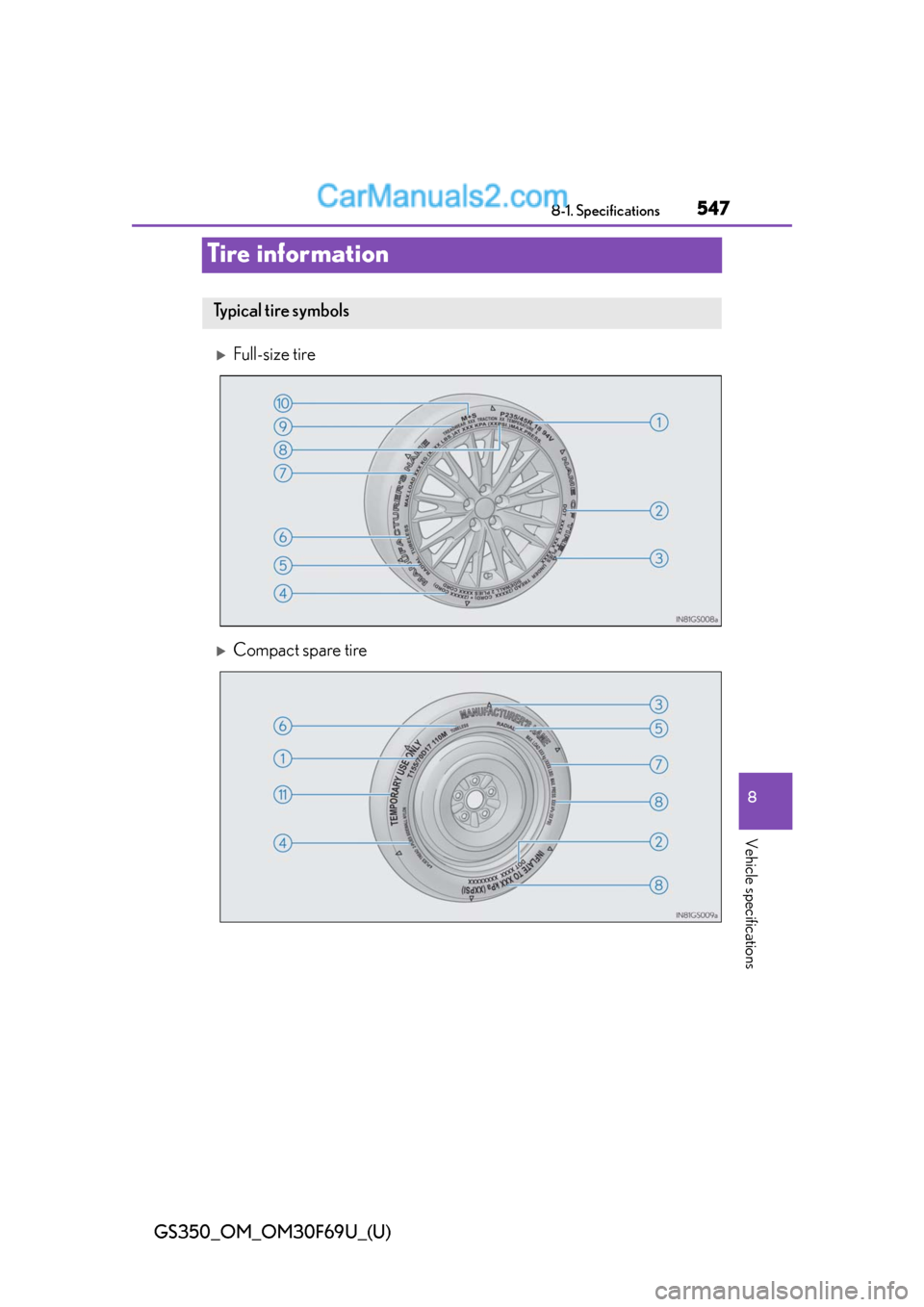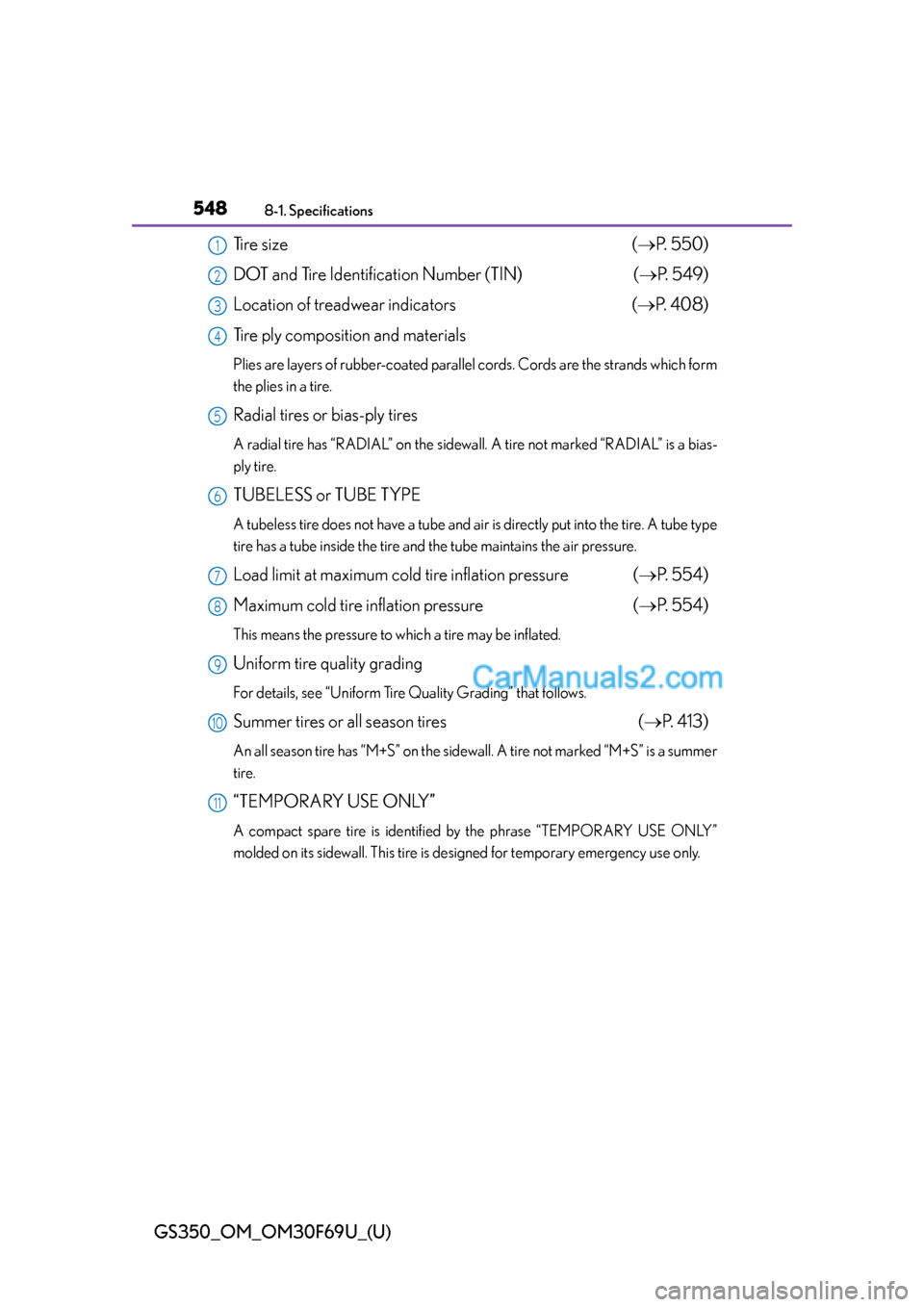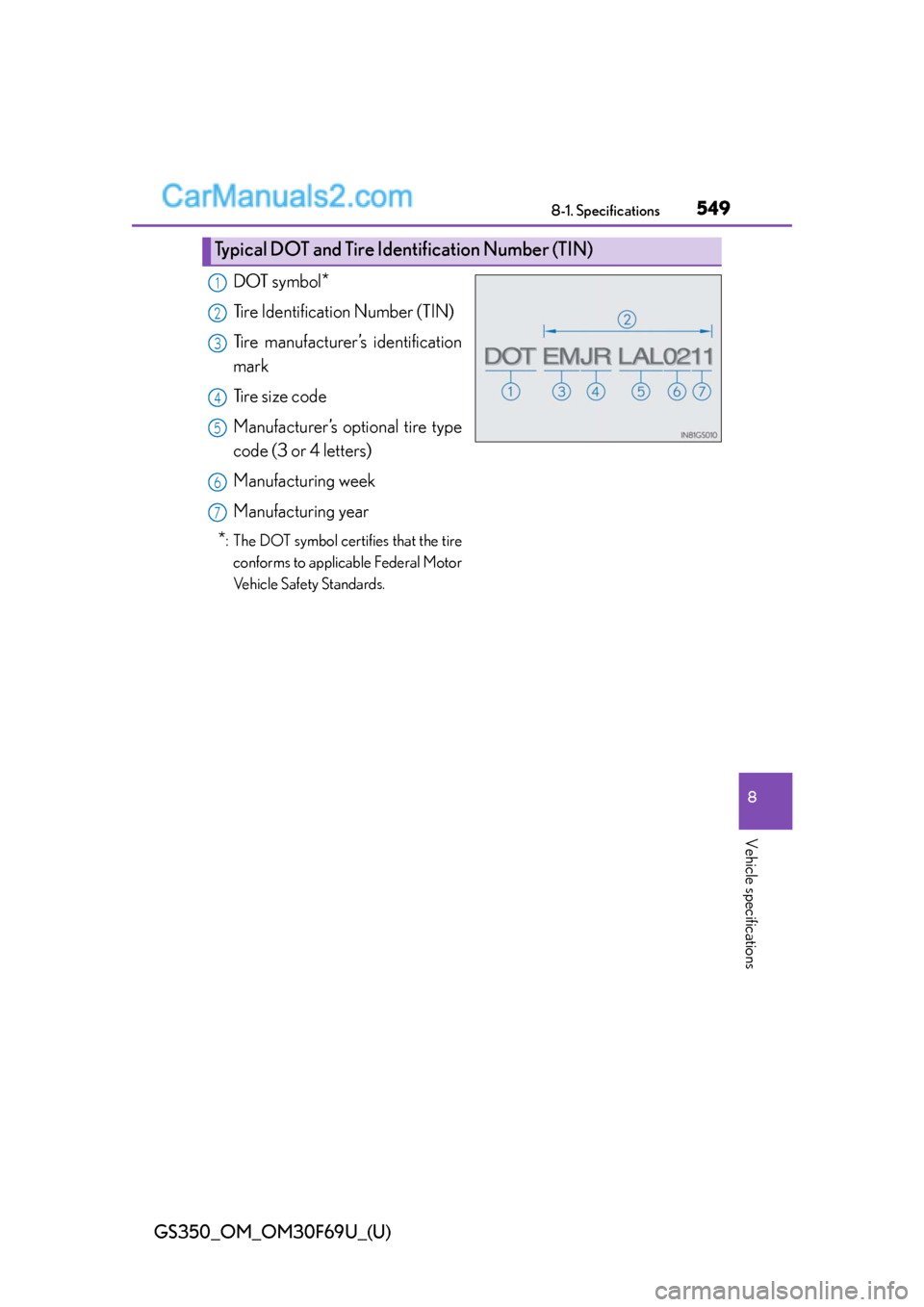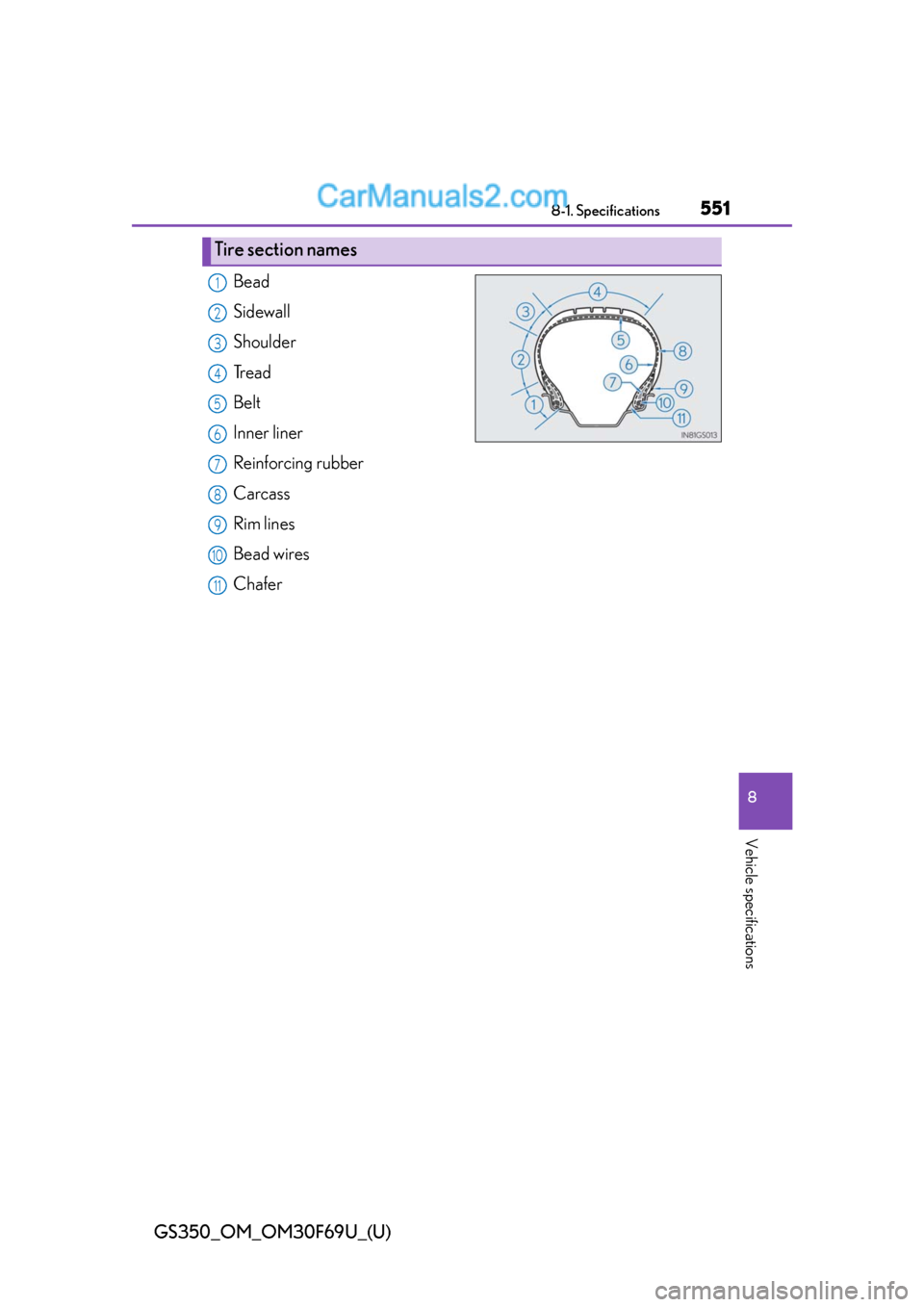Lexus GS350 2015 Specifications
Manufacturer: LEXUS, Model Year: 2015, Model line: GS350, Model: Lexus GS350 2015Pages: 25, PDF Size: 1.07 MB
Page 11 of 25

544
GS350_OM_OM30F69U_(U)
8-1. Specifications
Fuel information
■Fuel tank opening for unleaded gasoline
To help prevent incorrect fueling, your vehicle has a fuel tank opening that only
accommodates the special nozzle on unleaded fuel pumps.
■Gasoline quality
In very few cases, driveability problems may be caused by the brand of gasoline you
are using. If driveability problems persist, try changing the brand of gasoline. If this
does not correct the problem, consult your Lexus dealer.
■Gasoline quality standards
●Automotive manufacturers in the U.S.A., Europe and Japan have developed a
specification for fuel quality called the World-Wide Fuel Charter (WWFC), which
is expected to be applied worldwide.
●The WWFC consists of four categories that are based on required emission levels.
In the U.S., category 4 has been adopted.
●The WWFC improves air quality by lowering emissions in vehicle fleets, and
improves customer satisfaction through better performance.
You must only use unleaded gasoline in your vehicle.
Select premium unleaded gasoline with an octane rating of 91
(Research Octane Number 96) or higher required for optimum engine
performance. If 91 octane cannot be obtained, you may use unleaded
gasoline with an octane rating as low as 87 (Research Octane Number
91). Use of unleaded gasoline with an octane rating lower than 91 may
result in engine knocking and significantly reduced performance. Per-
sistent knocking can lead to engine damage and should be corrected
by refueling with higher octane unleaded gasoline.
At minimum, the gasoline you use should meet the specifications of
ASTM D4814 in the U.S.A..
Page 12 of 25

GS350_OM_OM30F69U_(U)
5458-1. Specifications
8
Vehicle specifications
■Recommendation of the use of gasoline containing detergent additives
●Lexus recommends the use of gasoline that contains detergent additives to avoid
the build-up of engine deposits.
●All gasoline sold in the U.S.A. contains minimum detergent additives to clean and/
or keep clean intake systems, per EPA’s lowest additives concentration program.
●Lexus strongly recommends the use of Top Tier Detergent Gasoline. For more
information on Top Tier Detergent Gasoline and a list of marketers, please go to the
official website www.toptiergas.com.
■Recommendation of the use of cleaner burning gasoline
Cleaner burning gasoline, including reformulated gasoline that contains oxygenates
such as ethanol or MTBE (Methyl Tertiary Butyl Ether) is available in many areas.
Lexus recommends the use of cleaner burning gasoline and appropriately blended
reformulated gasoline. These types of gasoline provide excellent vehicle perfor-
mance, reduce vehicle emissions and improve air quality.
■Non-recommendation of the use of blended gasoline
●If you use gasohol in your vehicle, be sure that it has an octane rating no lower than
87.
●Lexus does not recommend the use of gasoline containing methanol.
●Use only gasoline containing up to 15% eth-
anol.
DO NOT use any flex-fuel or gasoline that
could contain more than 15% ethanol,
including from any pump labeled E30, E50,
E85 (which are only some examples of fuel
containing more than 15% ethanol).DO NOT use gasoline con-
taining more than 15% ethanol.
(30% ethanol)
(50% ethanol)
(85% ethanol)
Page 13 of 25

546
GS350_OM_OM30F69U_(U)
8-1. Specifications
■Non-recommendation of the use of gasoline containing MMT
Some gasoline contains an octane enhancing additive called MMT (Methylcyclo-
pentadienyl Manganese Tricarbonyl).
Lexus does not recommend the use of gasoline that contains MMT. If fuel containing
MMT is used, your emission control system may be adversely affected.
The malfunction indicator lamp on the instrument cluster may come on. If this hap-
pens, contact your Lexus dealer for service.
■If your engine knocks
●Consult your Lexus dealer.
●You may occasionally notice light knocking for a short time while accelerating or
driving uphill. This is normal and there is no need for concern.
NOTICE
■Notice on fuel quality
●Do not use improper fuels. If improper fuels are used, the engine will be dam-
aged.
●Do not use leaded gasoline.
Leaded gasoline can cause damage to your vehicle’s three-way catalytic convert-
ers causing the emission control system to malfunction.
●Do not use gasohol other than the type previously stated.
Other gasohol may cause fuel system damage or vehicle performance problems.
●Using unleaded gasoline with an octane number or rating lower than the level
previously stated will cause persistent heavy knocking.
At worst, this will lead to engine damage.
■Fuel-related poor driveability
If poor driveability is encountered after using a different type of fuel (poor hot start-
ing, vaporization, engine knocking, etc.), discontinue the use of that type of fuel.
■When refueling with gasohol
Take care not to spill gasohol. It can damage your vehicle’s paint.
Page 14 of 25

547
GS350_OM_OM30F69U_(U)8-1. Specifications
8
Vehicle specifications
Tire information
Full-size tire
Compact spare tire
Typical tire symbols
Page 15 of 25

548
GS350_OM_OM30F69U_(U)
8-1. Specifications
Tire size (P. 550)
DOT and Tire Identification Number (TIN) (P. 549)
Location of treadwear indicators (P. 4 0 8 )
Tire ply composition and materials
Plies are layers of rubber-coated parallel cords. Cords are the strands which form
the plies in a tire.
Radial tires or bias-ply tires
A radial tire has “RADIAL” on the sidewall. A tire not marked “RADIAL” is a bias-
ply tire.
TUBELESS or TUBE TYPE
A tubeless tire does not have a tube and air is directly put into the tire. A tube type
tire has a tube inside the tire and the tube maintains the air pressure.
Load limit at maximum cold tire inflation pressure (P. 5 5 4 )
Maximum cold tire inflation pressure (P. 5 5 4 )
This means the pressure to which a tire may be inflated.
Uniform tire quality grading
For details, see “Uniform Tire Quality Grading” that follows.
Summer tires or all season tires (P. 413)
An all season tire has “M+S” on the sidewall. A tire not marked “M+S” is a summer
tire.
“TEMPORARY USE ONLY”
A compact spare tire is identified by the phrase “TEMPORARY USE ONLY”
molded on its sidewall. This tire is designed for temporary emergency use only.
1
2
3
4
5
6
7
8
9
10
11
Page 16 of 25

GS350_OM_OM30F69U_(U)
5498-1. Specifications
8
Vehicle specifications
DOT symbol*
Tire Identification Number (TIN)
Tire manufacturer’s identification
mark
Ti r e s i z e c o d e
Manufacturer’s optional tire type
code (3 or 4 letters)
Manufacturing week
Manufacturing year
*: The DOT symbol certifies that the tire
conforms to applicable Federal Motor
Vehicle Safety Standards.
Typical DOT and Tire Identification Number (TIN)
1
2
3
4
5
6
7
Page 17 of 25

550
GS350_OM_OM30F69U_(U)
8-1. Specifications
■Typical tire size information
The illustration indicates typical
tire size.
Tire use (P = Passenger car,
T = Temporary use)
Section width (millimeters)
Aspect ratio
(tire height to section width)
Tire construction code
(R = Radial, D = Diagonal)
Wheel diameter (inches)
Load index
(2 digits or 3 digits)
Speed symbol
(alphabet with one letter)
■Tire dimensions
Section width
Tire height
Wheel diameter
Tire size
1
2
3
4
5
6
7
1
2
3
Page 18 of 25

GS350_OM_OM30F69U_(U)
5518-1. Specifications
8
Vehicle specifications
Bead
Sidewall
Shoulder
Tread
Belt
Inner liner
Reinforcing rubber
Carcass
Rim lines
Bead wires
Chafer
Tire section names
1
2
3
4
5
6
7
8
9
10
11
Page 19 of 25

552
GS350_OM_OM30F69U_(U)
8-1. Specifications
This information has been prepared in accordance with regulations issued
by the National Highway Traffic Safety Administration of the U.S. Depart-
ment of Transportation.
It provides the purchasers and/or prospective purchasers of Lexus vehi-
cles with information on uniform tire quality grading.
Your Lexus dealer will help answer any questions you may have as you read this
information.
■DOT quality grades
All passenger vehicle tires must conform to Federal Safety Require-
ments in addition to these grades. Quality grades can be found where
applicable on the tire sidewall between tread shoulder and maximum
section width.
For example: Treadwear 200 Traction AA Temperature A
■Treadwear
The treadwear grade is a comparative rating based on the wear rate of
the tire when tested under controlled conditions on a specified govern-
ment test course.
For example, a tire graded 150 would wear one and a half (1 - 1 /2) times as well
on the government course as a tire graded 100.
The relative performance of tires depends upon the actual conditions of their
use. Performance may differ significantly from the norm due to variations in
driving habits, service practices and differences in road characteristics and cli-
mate.
■Traction AA, A, B, C
The traction grades, from highest to lowest, are AA, A, B and C, and
they represent the tire’s ability to stop on wet pavement as measured
under controlled conditions on specified government test surfaces of
asphalt and concrete.
A tire marked C may have poor traction performance.
Warning: The traction grade assigned to this tire is based on braking (straight
ahead) traction tests and does not include cornering (turning) traction.
Uniform Tire Quality Grading
Page 20 of 25

GS350_OM_OM30F69U_(U)
5538-1. Specifications
8
Vehicle specifications
■Temperature A, B, C
The temperature grades are A (the highest), B, and C, representing the
tire’s resistance to the generation of heat and its ability to dissipate heat
when tested under controlled conditions on a specified indoor labora-
tory test wheel.
Sustained high temperature can cause the material of the tire to degenerate
and reduce tire life, and excessive temperature can lead to sudden tire failure.
Grade C corresponds to a level of performance which all passenger car tires
must meet under the Federal Motor Vehicle Safety Standard No. 109.
Grades B and A represent higher levels of performance on the laboratory test
wheel than the minimum required by law.
Warning: The temperature grades of a tire assume that it is properly inflated
and not overloaded.
Excessive speed, underinflation, or excessive loading, either separately or in
combination, can cause heat buildup and possible tire failure.